Gennaro Cuofano's Blog, page 173
January 31, 2021
MOZ Review
MOZ is another popular all in one suite of SEO tools. One of the best things about MOZ is that it is very easy to use and you do not have to be technical at all to navigate the platform. As said earlier, it is an all in one suite and thus packs all the essentials for devising effective SEO strategies. MOZ has six major tools, which further have multiple functionalities; however, we are going to focus on these six tools for now;
Keyword ResearchRank TrackingSite CrawlOn-Page OptimizationLink ResearchCustom ReportsWe will go through each of the six one by one starting with Keyword Research.
Keyword ResearchAs discussed previously, keyword research is of immense importance to devising any SEO strategy. MOZ has developed one of the best keyword research tools, which takes the hassle, bad data and busywork out of the process and improves the process of discovering the best keywords to work on and target in a short amount of time. The keyword research tool by MOZ allows you to create, add and manage keyword lists all inside MOZ. You can then compare, categorize and prioritize any given number of keywords and phrases in order to choose your target keyword and fine-tune your content strategy. The main purpose that the keyword research tools however serves is the opportunity to find even better keywords with the help of MOZ’s intuitive suggestions and comparable keywords for which other sites are ranking. These keywords are collected from a high quality keyword database, which only contains fresh SERP data of age two weeks or less. Finally, I think what makes MOZ keyword research stand out from many other tools is that it provides many important metrics about the keywords in order to better gauge its competitiveness and estimate click through rates. These metrics include difficulty, Organic CTR, volume etc. that helps assess the right keyword for your content strategy.

MOZ Keyword Explorer
Rank TrackingThe second most important functionality that exists on MOZ is that of rank tracking. In the digital marketing game, everything is about getting your website to rank higher, but how does one know where they stand on a search engine’s SERPs. That is where rank tracking by MOZ comes in. It helps you track your website’s keyword ranking and visibility on Google SERP. That is how you know which strategies are working and which ones need changing. It also helps you track your competitor’s movement on the SERP, thus allowing you to find gaps in their SEO strategies and build upon that. Customers have over the time shown different search behavior on different devices i.e. desktop and mobile devices. MOZ helps you compare your website rankings across different devices and shows you the gaps upon which you can improve. All these strategies combined together lets you uncover competitive advantages over what others in the same field as you are doing and thus push your rank higher on the SERPs.

MOZ Rank Checker
Site Crawl and AuditIf you already have an intact website and are not building one from scratch, it is important that you find out all the areas where the site lags and what structural and navigational hindrances are hidden in the code. MOZ site crawl and audit tool can help you detect these technical issues which might be impeding your website from receiving high quality traffic, rank of being indexed by the search engines. Through this tool, MOZ monitors a multitude of issues including missing title tags, broken redirects and many more. The best part is that MOZ crawler works fast and efficiently, since it keeps track of the new and recurring issues thus making them easy to detect. The results of the site audit then show the issues in the form of categories and colorful charts depicting the trends, opportunities and the severity of the issues. MOZ site audit tool also explains each and every issue in detail, with its potential impact on your site’s ranking and traffic as well as recommends a possible solution. Then you can take the next steps, as you deem appropriate. Finally, an important feature of the MOZ site crawl tool is that it automatically crawls your website after set time periods and informs you of any new issues that might be lurking in your site.

MOZ Site Crawl and Audit
On-page OptimizationAfter you have successfully ranked your website and applied all the useful strategies, it is important that your content be worth reading. Otherwise, the visitor may come on your site, but they would not stay long if finding information is difficult, thus decreasing your retention rate, which could directly lead to a drop in sales, if you are a business. MOZ makes sure that does not happen with its on-page optimization page. MOZ gives you a list of recommendations along with easy to follow steps to ensure that your page content is optimized to meet the search engine’s retention requirements. An important metric called page optimization score helps you identify the ranking potential of every single page on your website, so you can quickly identify improvement opportunities on the pages with highest ranking potential. On top of that, MOZ on-page optimization tool also gives you suggestions and new content ideas to make sure that your website becomes the authority in your niche and whenever a customer enters that specific keyword, it is your name that pops up on the top.

MOZ On-page optimization tool
Link BuildingFinally, MOZ can give you insights about your website’s authority and ranking by measuring the link juice of your website. The amount of backlinks, linking domains, anchor text and most valuable pages decide for the most part as to how high your website ranks. What MOZ does is compares your link profile with four of your competitors and identifies the gaps that exist between the domain authorities of the two websites. You can then carry out similar efforts to increase your site’s domain authority. MOZ also provides you with a link tracking list that can be utilized to set goals, track and analyze your link building progress.

MOZ Link Explorer
Main Free Guides:
Business ModelsBusiness StrategyBusiness DevelopmentDigital Business ModelsDistribution ChannelsMarketing StrategyPlatform Business ModelsTech Business ModelThe post MOZ Review appeared first on FourWeekMBA.
Hubspot Review
Founded in 2006, by Brian Halligan and Dharmesh Shah, HubSpot is much more than just a marketing tool. It is in fact a one-stop shop and a complete CRM platform with all the tools and integrations that your business is ever going to need. Whether it is that you want to accelerate your sales, increase your marketing efforts, streamline your customer service or just build a power website, HubSpot does it all. The CRM platform is made up of four major hubs named;
Service HubSales HubCMS HubMarketing HubThe service hub is a customer service software that helps business owners connect with their customers, helps build brand loyalty turning those customers into promoters who help grow your business. Similarly, the sales hub is primarily a CRM software, which helps you automate all the boring tasks, gives you deeper insight into your potential clients and helps you close deals faster. It comes equipped with features like advanced CRM, quotes and meeting scheduling options. The third one is a content management software, which helps you create a website that leaves a lasting impression. With tools like drag-and-drop editor, SEO recommendations and a multitude of themes, you are bound to give your customers a personalized and safe experience. Finally the one most relevant to our cause is the marketing hub, which entails a marketing software which helps you do a ton of things to promote your brand online. Since today we are only talking about digital marketing, we will go into the details of tools and features that the marketing hub of HubSpot is equipped with.
The HubSpot Marketing Hub is actually a marketing automation software designed to help you reach out to the right audience, convert your website traffic into sales and run effective and inbound marketing campaigns at a scale. All of this is done under a single roof using the powerful yet easy-to-use platform. The major functionalities of the marketing hub are divided into three parts and each part comes loaded with features;
Attract AttentionThe first and foremost focus of the HubSpot marketing hub is at creating content that your potential customers are looking forward to, and is impossible to miss. Marketing hub helps you publish content that helps your site get discovered in search engines, social media platforms and beyond. By adding calls to action, it converts readers into customers. Similarly, the SEO tool helps your website build its search authority to outrank competitors. The SEO tools integrated into the platform not only help you plan your content strategy but also optimize your content as you type.
The Ad tracking and management feature helps you cut down on your ad spend. You no longer have to struggle between Facebook, Instagram, LinkedIn and Google ads, instead you can run ad campaigns, manage and track them right inside HubSpot. It also lets you see which ads are turning prospects into actual sales. The integrated social media management platform lets you do everything else as well such as publishing on social media platforms, the same ad campaigns you created using HubSpot. It also helps you monitor each and every interaction with a customer on any of your platforms. HubSpot also supports video files by storing them right inside HubSpot and embedding them on your website or social media platforms when needed and as needed. Finally, it lets you connect with your customers in live chat and uses bots to qualify leads and save you some precious human hours.

Figure 6: HubSpot – Creating Content that your prospects crave
Converting More LeadsThe second major functionality that HubSpot focuses on is converting leads into actual customers with personalized strategy. HubSpot carries out a number of carefully curated actions to convert those leads into prospects. The first one is the design and launch of an appealing landing page. It lets you choose from pre-configured templates, which you can customize to the exact needs of your business, or you can always start from scratch. An appealing landing page is the key to retaining customers. The tool also helps you build easily customizable forms, which you can add to your website to convert your anonymous visitors into leads.

Figure 7: HubSpot: Lead Conversion
The best part of all is that it completely automates all these processes not only saving you time but also helping you scale up your efforts on things that matter the most. When cross-functional operations are automated and bulk data is being managed, you can work on nurturing leads and personalizing emails. Email marketing is an important aspect of digital marketing. HubSpot lets you create mobile-optimized email campaigns that look the same as a professionally designed email and gives you the window to personalize the message as per each recipient. This helps you build deeper relationships with your customers and utilize collaborative and intuitive account based marketing tools for your highest value targets.
Finally, with lead tracking and management, you are always on top of your lead game, getting a full picture on the status of every lead in an integrated database. Then you can proceed to segment leads based on the data available and nurture each one of them at a different pace.
Report & CustomizeFinally, the focus is on customizing your platform in order to give marketing the credit it deserves. HubSpot is equipped with built-in marketing analytics, reports and dashboards, which help you make smarter, data-backed decisions. Based on these decisions, you can then customize your platform in a way that it is in coherence with what data indicates and indirectly what the customer wants.

Figure 8: HubSpot – Marketing Analytics
Lastly, given that HubSpot is a comprehensive CRM platform, it allows the integration of Salesforce for bi-directional yet faster sync, thus allowing you to send all this lead intelligence to your sales team so they not only have the information about who is your prospect customer but also the complete context on how to approach them.
Main Free Guides:
Business ModelsBusiness StrategyBusiness DevelopmentDigital Business ModelsDistribution ChannelsMarketing StrategyPlatform Business ModelsTech Business ModelThe post Hubspot Review appeared first on FourWeekMBA.
SEMRush Review
SEMrush is one of the most popular digital marketing tool trusted by internet marketers all over the world. With a massive database of over 46 million domains and 120 million keywords, it is the go to tool for small and large businesses alike. Companies like Philips, Forbes, Hyatt and Paypal are amongst its top users. It is an all-in-one tool suit for not only improving your business’ online visibility but also discovering marketing insights that can help you make better decisions regarding your marketing spend. SEMrush mainly focuses on areas including SEO, SMM, PPC, Keyword Research, PR, Content Marketing, Campaign Management and Competitor Research. All these tools combined is all that there is to digital marketing, so if you are able to fully reap the potential of SEMrush, your business would be set for bigger things.
Let us now take a look at these features in detail;
Keyword ResearchIf you know even the ABC of the world of digital marketing, you would be aware of the fact that keywords are of immense importance and successful keyword research can be a game changer for any business. With the SEMrush keyword research tool, you can easily outperform your competitors. There are a number of ways in which the keyword research tool facilitates your business and gives you a competitive edge over others. The first one being keyword overview, which lets you find out the potential value of any keyword.
From instantly judging the keyword on set parameters such as estimated value and the competition that the keyword has to discovering how the keyword actually fits your goal, the Keyword research tool does it all. It also helps you analyze a complete list of your competitor’s organic keyword rankings and pages. This way you not only discover the best performing organic keywords for your niche but you can also target each of those keywords individually and find new ways to win SERPs.
The Keyword Research tool also has a database of over 20 billion keywords, which it lets you surf through a friendly and streamlined interface. The integrated keyword manager helps users analyze up to a 1000 keywords at a time and see changes for a keyword in the search engine results in real time. Finally, the keyword research tool also allows you to compare your keyword profile with that of your competitor and device new strategies for launching more efficient SEO campaigns.
 On-Page SEO
On-Page SEOThe term on-page SEO refers to the practice of optimizing your website’s individual web pages in a way as to rank higher and earn relevant traffic when a query is made on a search engine. On-page SEO is relevant to applying all the SEO best practices to the web content as well as the html code in order to boost your page rankings. The SEMrush on-page SEO tool lets you analyze your website’s health by checking the interactions that it has with Google, thus providing you with fresh ranking ideas. The on-page SEO tool lets you run a complete audit of your website’s pages with the help of a high-speed crawler in a matter of minutes, which then recommends easy fixes for all the issues that plague your website. It also gives you an exhaustive list of ideas to improve your website’s rank by applying tips related to content writing, link building and SERP feature targeting. Finally, it helps you analyze log files of your website’s interactions with Google crawler to help overcome any hindrances that there might be due to both structural and navigational issues in your website.

Figure 2: SEMrush On-page SEO Tool
Local SEOLocal SEO is a digital marketing strategy for a business that has a physical store or location and serves a set local geographic area. Thus, local SEO gives you the tools to promote your product in your own locality when people search for it on the internet. SEMrush local SEO tool can sculpt the perfect strategy for your small business. It has a multitude of features such as listing management, which puts your business data into the most authoritative directories automatically and follows your ranking progress on your locality’s zip code level while monitoring reviews in those directories. The Local SEO tools also makes the use of position tracking feature to track your daily online performance by monitoring device types, keywords and keeping an eye on the competition in the area. It also does an on page SEO check for your website as compared to your local competition by analyzing their strategies and trends in your area. Finally, it also lets you enhance your social media performance allowing you to harness the full power of all those sales channels.

Figure 3: SEMrush Local SEO Tool
SEO Competitive AnalysisIn business terms, competitive analysis is a strategy in which you identify all your major competitors and then research their marketing strategies, sales and products inside out and then devise strategies on top of what your competitor is already doing. SEMrush competitive analysis tool lets you analyze your competition in a matter of minutes. All you need to do is enter your competitor’s domain name, and it will show you everything from your competitor’s organic search rankings and position changes to all their keywords that they are ranking on. Using this same tool, you can also see all of their backlinks and thus find all their referring domains and by applying the right filters, you can uncover unlimited new opportunities to find new backlinks for your website. The competitive analysis tools lets you analyze up to five competitors at a time, uncovering the gaps in the keyword strategies that you can put all your focus on. Similarly, you can do this same gap analysis for backlinks as well, find out which domains link your competitors and not you, and then reach out to them to build your own backlinks to those authoritative sites. You can get all of this information in the form of comprehensive SEMrush reports that you can share with your team to work on and devise better strategies.

Figure 4: SEMrush competitive analysis tool
Rank TrackingAnother useful tool that SEMrush incorporates is called rank tracking which helps you monitor your performance on Google’s SERPs and then develop your SEO strategy accordingly. The first technique is the one we discussed earlier called position tracking which helps you track keywords, competitors and domains on Google as well as your own campaign progress, spot and fix cannibalization and then taking the next steps accordingly. Similarly, SEMrush also allows you to track the volatility of different search engine’s SERPs based on daily changes that occur in them. Lastly, it allows you to narrow down on domains that have higher rankings globally with the most organic visibility, similarly the ones with paid visibility and traffic to give you an idea of what you need to do even to achieve a fraction of that traffic.

Figure 5: SEMrush rank tracking tool
Other FeaturesSince we are focusing on the marketing and more specifically the SEO aspect of it, we discussed all the major tools that SEMrush houses that help websites build their SEO strategy. However there are a number of other tools that SEMrush comes equipped with that we think are worth mentioning here.
Content – In the content category, SEMrush has a wide variety of tools and features including content marketing, content creation and distribution, content optimization and last but not least content marketing analytics. Market Research – SEMrush also helps businesses carry out market research with tools such as competitor analysis, market analysis, paid advertising and competitor PR monitoring. Advertising – In the advertising niche, SEMrush facilitates its users with tools and techniques such as PPC keyword research and website monetization. SMM & SERM – Lastly, it also helps with social media management.Main Free Guides:
Business ModelsBusiness StrategyBusiness DevelopmentDigital Business ModelsDistribution ChannelsMarketing StrategyPlatform Business ModelsTech Business ModelThe post SEMRush Review appeared first on FourWeekMBA.
January 29, 2021
Theories of Motivation
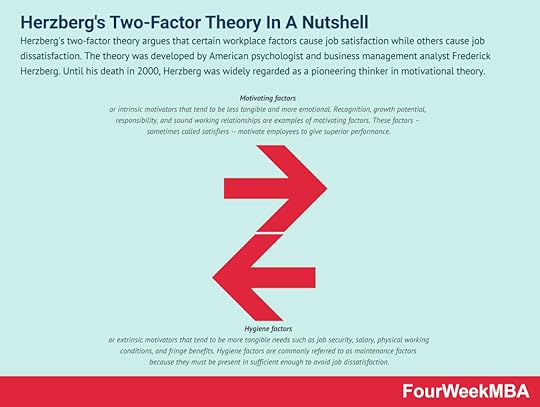 Herzberg’s two-factor theory argues that certain workplace factors cause job satisfaction while others cause job dissatisfaction. The theory was developed by American psychologist and business management analyst Frederick Herzberg. Until his death in 2000, Herzberg was widely regarded as a pioneering thinker in motivational theory.
Herzberg’s two-factor theory argues that certain workplace factors cause job satisfaction while others cause job dissatisfaction. The theory was developed by American psychologist and business management analyst Frederick Herzberg. Until his death in 2000, Herzberg was widely regarded as a pioneering thinker in motivational theory.  Maslow’s Hierarchy of Needs was developed by American psychologist Abraham Maslow. His hierarchy, often depicted in the shape of a pyramid, helped explain his research on basic human needs and desires. In marketing, the hierarchy (and its basis in psychology) can be used to market to specific groups of people based on their similarly specific needs, desires, and resultant actions.
Maslow’s Hierarchy of Needs was developed by American psychologist Abraham Maslow. His hierarchy, often depicted in the shape of a pyramid, helped explain his research on basic human needs and desires. In marketing, the hierarchy (and its basis in psychology) can be used to market to specific groups of people based on their similarly specific needs, desires, and resultant actions.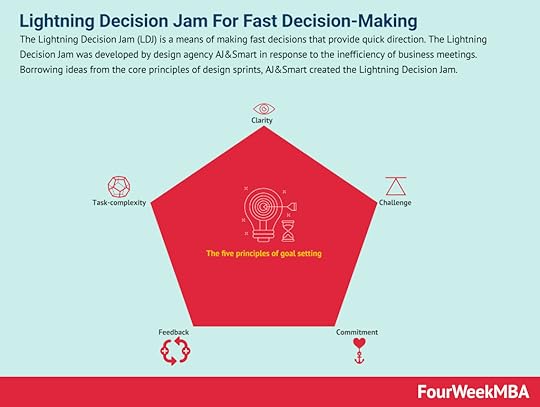 The theory was developed by psychologist Edwin Locke who also has a background in motivation and leadership research. Locke’s goal-setting theory of motivation provides a framework for setting effective and motivating goals. Locke was able to demonstrate that goal setting was linked to performance.
The theory was developed by psychologist Edwin Locke who also has a background in motivation and leadership research. Locke’s goal-setting theory of motivation provides a framework for setting effective and motivating goals. Locke was able to demonstrate that goal setting was linked to performance. A SOAR analysis is a technique that helps businesses at a strategic planning level to:Focus on what they are doing right.Determine which skills could be enhanced.Understand the desires and motivations of their stakeholders.
A SOAR analysis is a technique that helps businesses at a strategic planning level to:Focus on what they are doing right.Determine which skills could be enhanced.Understand the desires and motivations of their stakeholders.Main Free Guides:
Business ModelsBusiness StrategyBusiness DevelopmentDigital Business ModelsDistribution ChannelsMarketing StrategyPlatform Business ModelsTech Business ModelThe post Theories of Motivation appeared first on FourWeekMBA.
Time Management Frameworks
 The theory was developed by psychologist Edwin Locke who also has a background in motivation and leadership research. Locke’s goal-setting theory of motivation provides a framework for setting effective and motivating goals. Locke was able to demonstrate that goal setting was linked to performance.
The theory was developed by psychologist Edwin Locke who also has a background in motivation and leadership research. Locke’s goal-setting theory of motivation provides a framework for setting effective and motivating goals. Locke was able to demonstrate that goal setting was linked to performance.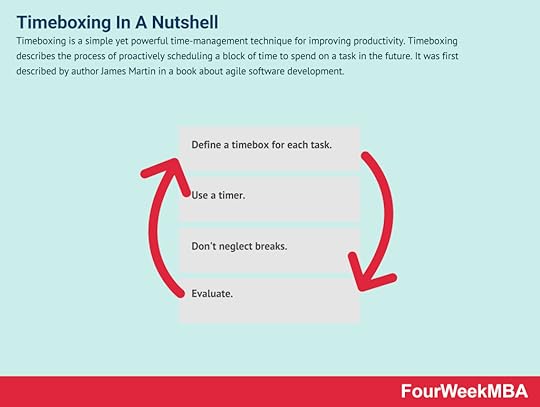 Timeboxing is a simple yet powerful time-management technique for improving productivity. Timeboxing describes the process of proactively scheduling a block of time to spend on a task in the future. It was first described by author James Martin in a book about agile software development.
Timeboxing is a simple yet powerful time-management technique for improving productivity. Timeboxing describes the process of proactively scheduling a block of time to spend on a task in the future. It was first described by author James Martin in a book about agile software development. A SMART goal is any goal with a carefully planned, concise, and trackable objective. To be such a goal needs to be specific, measurable, achievable, relevant, and time-based. Bringing structure and trackability to goal setting increases the chances goals will be achieved, and it helps align the organization around those goals.
A SMART goal is any goal with a carefully planned, concise, and trackable objective. To be such a goal needs to be specific, measurable, achievable, relevant, and time-based. Bringing structure and trackability to goal setting increases the chances goals will be achieved, and it helps align the organization around those goals. The Pomodoro Technique was created by Italian business consultant Francesco Cirillo in the late 1980s. The Pomodoro Technique is a time management system where work is performed in 25-minute intervals.
The Pomodoro Technique was created by Italian business consultant Francesco Cirillo in the late 1980s. The Pomodoro Technique is a time management system where work is performed in 25-minute intervals.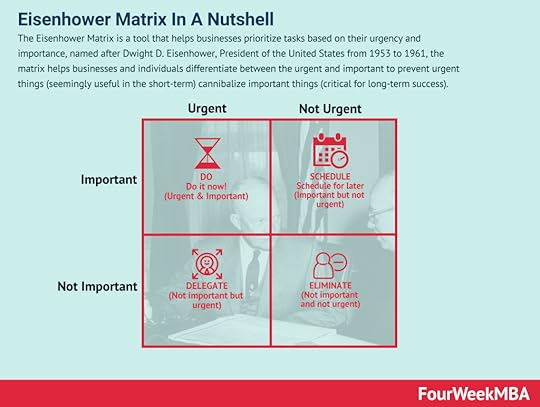 The Eisenhower Matrix is a tool that helps businesses prioritize tasks based on their urgency and importance, named after Dwight D. Eisenhower, President of the United States from 1953 to 1961, the matrix helps businesses and individuals differentiate between the urgent and important to prevent urgent things (seemingly useful in the short-term) cannibalize important things (critical for long-term success).
The Eisenhower Matrix is a tool that helps businesses prioritize tasks based on their urgency and importance, named after Dwight D. Eisenhower, President of the United States from 1953 to 1961, the matrix helps businesses and individuals differentiate between the urgent and important to prevent urgent things (seemingly useful in the short-term) cannibalize important things (critical for long-term success).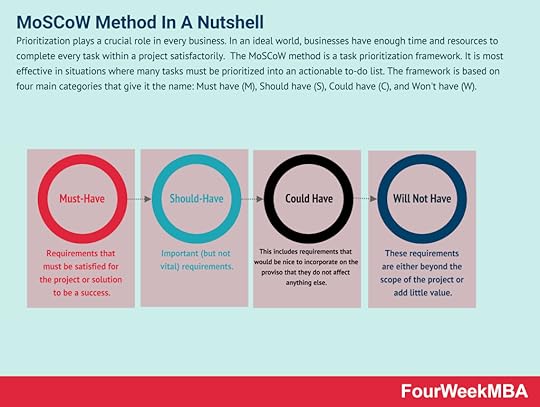 Prioritization plays a crucial role in every business. In an ideal world, businesses have enough time and resources to complete every task within a project satisfactorily. The MoSCoW method is a task prioritization framework. It is most effective in situations where many tasks must be prioritized into an actionable to-do list. The framework is based on four main categories that give it the name: Must have (M), Should have (S), Could have (C), and Won’t have (W).
Prioritization plays a crucial role in every business. In an ideal world, businesses have enough time and resources to complete every task within a project satisfactorily. The MoSCoW method is a task prioritization framework. It is most effective in situations where many tasks must be prioritized into an actionable to-do list. The framework is based on four main categories that give it the name: Must have (M), Should have (S), Could have (C), and Won’t have (W). An action priority matrix is a productivity tool that helps businesses prioritize certain tasks and objectives over others. The matrix itself is represented by four quadrants on a typical cartesian graph. These quadrants are plotted against the effort required to complete a task (x-axis) and the impact (benefit) that each task brings once completed (y-axis). This matrix helps assess what projects need to be undertaken and the potential impact for each.
An action priority matrix is a productivity tool that helps businesses prioritize certain tasks and objectives over others. The matrix itself is represented by four quadrants on a typical cartesian graph. These quadrants are plotted against the effort required to complete a task (x-axis) and the impact (benefit) that each task brings once completed (y-axis). This matrix helps assess what projects need to be undertaken and the potential impact for each.Main Free Guides:
Business ModelsBusiness StrategyBusiness DevelopmentDigital Business ModelsDistribution ChannelsMarketing StrategyPlatform Business ModelsTech Business ModelThe post Time Management Frameworks appeared first on FourWeekMBA.
Software Development Methods
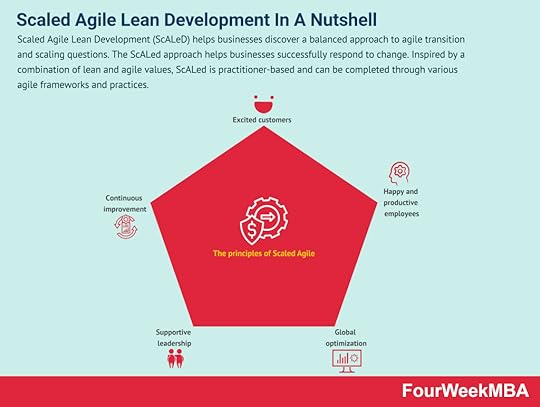 Scaled Agile Lean Development (ScALeD) helps businesses discover a balanced approach to agile transition and scaling questions. The ScALed approach helps businesses successfully respond to change. Inspired by a combination of lean and agile values, ScALed is practitioner-based and can be completed through various agile frameworks and practices.
Scaled Agile Lean Development (ScALeD) helps businesses discover a balanced approach to agile transition and scaling questions. The ScALed approach helps businesses successfully respond to change. Inspired by a combination of lean and agile values, ScALed is practitioner-based and can be completed through various agile frameworks and practices.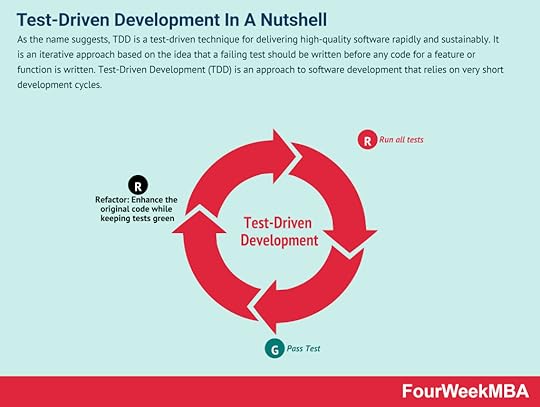 As the name suggests, TDD is a test-driven technique for delivering high-quality software rapidly and sustainably. It is an iterative approach based on the idea that a failing test should be written before any code for a feature or function is written. Test-Driven Development (TDD) is an approach to software development that relies on very short development cycles.
As the name suggests, TDD is a test-driven technique for delivering high-quality software rapidly and sustainably. It is an iterative approach based on the idea that a failing test should be written before any code for a feature or function is written. Test-Driven Development (TDD) is an approach to software development that relies on very short development cycles. Feature-Driven Development is a pragmatic software process that is client and architecture-centric. Feature-Driven Development (FDD) is an agile software development model that organizes workflow according to which features need to be developed next.
Feature-Driven Development is a pragmatic software process that is client and architecture-centric. Feature-Driven Development (FDD) is an agile software development model that organizes workflow according to which features need to be developed next. eXtreme Programming was developed in the late 1990s by Ken Beck, Ron Jeffries, and Ward Cunningham. During this time, the trio was working on the Chrysler Comprehensive Compensation System (C3) to help manage the company payroll system. eXtreme Programming (XP) is a software development methodology. It is designed to improve software quality and the ability of software to adapt to changing customer needs.
eXtreme Programming was developed in the late 1990s by Ken Beck, Ron Jeffries, and Ward Cunningham. During this time, the trio was working on the Chrysler Comprehensive Compensation System (C3) to help manage the company payroll system. eXtreme Programming (XP) is a software development methodology. It is designed to improve software quality and the ability of software to adapt to changing customer needs. Product discovery is a critical part of agile methodologies, as its aim is to ensure that products customers love are built. Product discovery involves learning through a raft of methods, including design thinking, lean start-up, and A/B testing to name a few. Dual Track Agile is an agile methodology containing two separate tracks: the “discovery” track and the “delivery” track.
Product discovery is a critical part of agile methodologies, as its aim is to ensure that products customers love are built. Product discovery involves learning through a raft of methods, including design thinking, lean start-up, and A/B testing to name a few. Dual Track Agile is an agile methodology containing two separate tracks: the “discovery” track and the “delivery” track. Timeboxing is a simple yet powerful time-management technique for improving productivity. Timeboxing describes the process of proactively scheduling a block of time to spend on a task in the future. It was first described by author James Martin in a book about agile software development.
Timeboxing is a simple yet powerful time-management technique for improving productivity. Timeboxing describes the process of proactively scheduling a block of time to spend on a task in the future. It was first described by author James Martin in a book about agile software development. RAD was first introduced by author and consultant James Martin in 1991. Martin recognized and then took advantage of the endless malleability of software in designing development models. Rapid Application Development (RAD) is a methodology focusing on delivering rapidly through continuous feedback and frequent iterations.
RAD was first introduced by author and consultant James Martin in 1991. Martin recognized and then took advantage of the endless malleability of software in designing development models. Rapid Application Development (RAD) is a methodology focusing on delivering rapidly through continuous feedback and frequent iterations.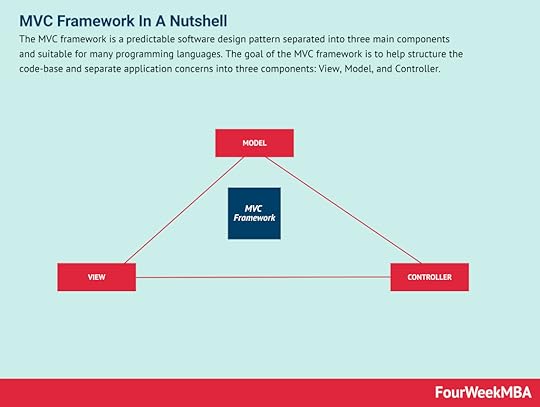 The MVC framework is a predictable software design pattern separated into three main components and suitable for many programming languages. The goal of the MVC framework is to help structure the code-base and separate application concerns into three components: View, Model, and Controller.
The MVC framework is a predictable software design pattern separated into three main components and suitable for many programming languages. The goal of the MVC framework is to help structure the code-base and separate application concerns into three components: View, Model, and Controller.  Agile started as a lightweight development method compared to heavyweight software development, which is the core paradigm of the previous decades of software development. By 2001 the Manifesto for Agile Software Development was born as a set of principles that defined the new paradigm for software development as a continuous iteration. This would also influence the way of doing business.
Agile started as a lightweight development method compared to heavyweight software development, which is the core paradigm of the previous decades of software development. By 2001 the Manifesto for Agile Software Development was born as a set of principles that defined the new paradigm for software development as a continuous iteration. This would also influence the way of doing business.  DevSecOps is a set of disciplines combining development, security, and operations. It is a philosophy that helps software development businesses deliver innovative products quickly without sacrificing security. This allows potential security issues to be identified during the development process – and not after the product has been released in line with the emergence of continuous software development practices.
DevSecOps is a set of disciplines combining development, security, and operations. It is a philosophy that helps software development businesses deliver innovative products quickly without sacrificing security. This allows potential security issues to be identified during the development process – and not after the product has been released in line with the emergence of continuous software development practices. Main Free Guides:
Business ModelsBusiness StrategyBusiness DevelopmentDigital Business ModelsDistribution ChannelsMarketing StrategyPlatform Business ModelsTech Business ModelThe post Software Development Methods appeared first on FourWeekMBA.
Organizational Development Frameworks
 Harvard Business School professor Dr. John Kotter has been a thought-leader on organizational change, and he developed Kotter’s 8-step change model, which helps business managers deal with organizational change. Kotter created the 8-step model to drive organizational transformation.
Harvard Business School professor Dr. John Kotter has been a thought-leader on organizational change, and he developed Kotter’s 8-step change model, which helps business managers deal with organizational change. Kotter created the 8-step model to drive organizational transformation. 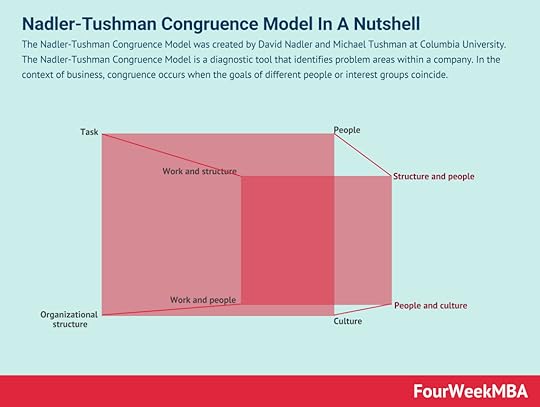 The Nadler-Tushman Congruence Model was created by David Nadler and Michael Tushman at Columbia University. The Nadler-Tushman Congruence Model is a diagnostic tool that identifies problem areas within a company. In the context of business, congruence occurs when the goals of different people or interest groups coincide.
The Nadler-Tushman Congruence Model was created by David Nadler and Michael Tushman at Columbia University. The Nadler-Tushman Congruence Model is a diagnostic tool that identifies problem areas within a company. In the context of business, congruence occurs when the goals of different people or interest groups coincide. McKinsey’s Seven Degrees of Freedom for Growth is a strategy tool. Developed by partners at McKinsey and Company, the tool helps businesses understand which opportunities will contribute to expansion, and therefore it helps to prioritize those initiatives.
McKinsey’s Seven Degrees of Freedom for Growth is a strategy tool. Developed by partners at McKinsey and Company, the tool helps businesses understand which opportunities will contribute to expansion, and therefore it helps to prioritize those initiatives. Mintzberg’s 5Ps of Strategy is a strategy development model that examines five different perspectives (plan, ploy, pattern, position, perspective) to develop a successful business strategy. A sixth perspective has been developed over the years, called Practice, which was created to help businesses execute their strategies.
Mintzberg’s 5Ps of Strategy is a strategy development model that examines five different perspectives (plan, ploy, pattern, position, perspective) to develop a successful business strategy. A sixth perspective has been developed over the years, called Practice, which was created to help businesses execute their strategies.  The COSO framework is a means of designing, implementing, and evaluating control within an organization. The COSO framework’s five components are control environment, risk assessment, control activities, information and communication, and monitoring activities. As a fraud risk management tool, businesses can design, implement, and evaluate internal control procedures.
The COSO framework is a means of designing, implementing, and evaluating control within an organization. The COSO framework’s five components are control environment, risk assessment, control activities, information and communication, and monitoring activities. As a fraud risk management tool, businesses can design, implement, and evaluate internal control procedures. The TOWS Matrix is an acronym for Threats, Opportunities, Weaknesses, and Strengths. The matrix is a variation on the SWOT Analysis, and it seeks to address criticisms of the SWOT Analysis regarding its inability to show relationships between the various categories.
The TOWS Matrix is an acronym for Threats, Opportunities, Weaknesses, and Strengths. The matrix is a variation on the SWOT Analysis, and it seeks to address criticisms of the SWOT Analysis regarding its inability to show relationships between the various categories.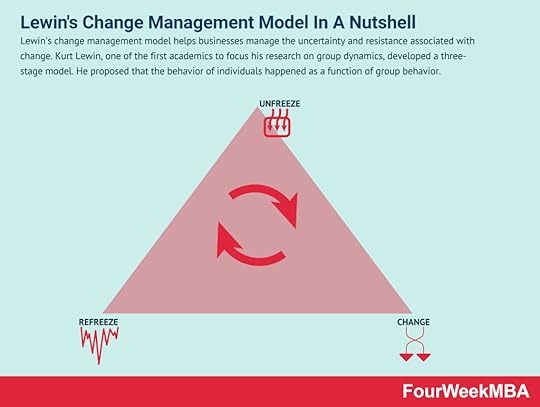 Lewin’s change management model helps businesses manage the uncertainty and resistance associated with change. Kurt Lewin, one of the first academics to focus his research on group dynamics, developed a three-stage model. He proposed that the behavior of individuals happened as a function of group behavior.
Lewin’s change management model helps businesses manage the uncertainty and resistance associated with change. Kurt Lewin, one of the first academics to focus his research on group dynamics, developed a three-stage model. He proposed that the behavior of individuals happened as a function of group behavior.  The Standard for Portfolio Management (SfPfM) describes a suite of portfolio management processes concerning programs, projects, and organizational strategy. The Standard for Portfolio Management is a creation of the Project Management Institute (PMI).
The Standard for Portfolio Management (SfPfM) describes a suite of portfolio management processes concerning programs, projects, and organizational strategy. The Standard for Portfolio Management is a creation of the Project Management Institute (PMI). Change is an important and necessary fact of life for all organizations. But change is often unsuccessful because the people within organizations are resistant to change. Change management is a systematic approach to managing the transformation of organizational goals, values, technologies, or processes.
Change is an important and necessary fact of life for all organizations. But change is often unsuccessful because the people within organizations are resistant to change. Change management is a systematic approach to managing the transformation of organizational goals, values, technologies, or processes. An organizational structure allows companies to shape their business model according to several criteria (like products, segments, geography and so on) that would enable information to flow through the organizational layers for better decision-making, cultural development, and goals alignment across employees, managers, and executives.
An organizational structure allows companies to shape their business model according to several criteria (like products, segments, geography and so on) that would enable information to flow through the organizational layers for better decision-making, cultural development, and goals alignment across employees, managers, and executives. Main Free Guides:
Business ModelsBusiness StrategyBusiness DevelopmentDigital Business ModelsDistribution ChannelsMarketing StrategyPlatform Business ModelsTech Business ModelThe post Organizational Development Frameworks appeared first on FourWeekMBA.
Group Decision-Making Frameworks
 The Six Thinking Hats model was created by psychologist Edward de Bono in 1986, who noted that personality type was a key driver of how people approached problem-solving. For example, optimists view situations differently from pessimists. Analytical individuals may generate ideas that a more emotional person would not, and vice versa.
The Six Thinking Hats model was created by psychologist Edward de Bono in 1986, who noted that personality type was a key driver of how people approached problem-solving. For example, optimists view situations differently from pessimists. Analytical individuals may generate ideas that a more emotional person would not, and vice versa.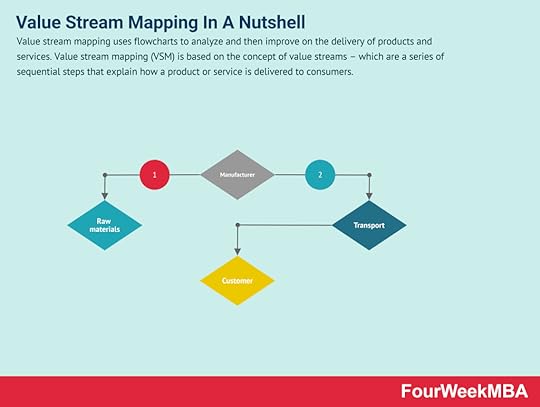 Value stream mapping uses flowcharts to analyze and then improve on the delivery of products and services. Value stream mapping (VSM) is based on the concept of value streams – which are a series of sequential steps that explain how a product or service is delivered to consumers.
Value stream mapping uses flowcharts to analyze and then improve on the delivery of products and services. Value stream mapping (VSM) is based on the concept of value streams – which are a series of sequential steps that explain how a product or service is delivered to consumers. Affinity grouping is a collaborative prioritization process where group participants brainstorm ideas and opportunities according to their similarities. Affinity grouping is a broad and versatile process based on simple but highly effective ideas. It helps teams generate and then organize teams according to their similarity or likeness.
Affinity grouping is a collaborative prioritization process where group participants brainstorm ideas and opportunities according to their similarities. Affinity grouping is a broad and versatile process based on simple but highly effective ideas. It helps teams generate and then organize teams according to their similarity or likeness. The Fishbone Diagram is a diagram-based technique used in brainstorming to identify potential causes for a problem, thus it is a visual representation of cause and effect. The problem or effect serves as the head of the fish. Possible causes of the problem are listed on the individual “bones” of the fish. This encourages problem-solving teams to consider a wide range of alternatives.
The Fishbone Diagram is a diagram-based technique used in brainstorming to identify potential causes for a problem, thus it is a visual representation of cause and effect. The problem or effect serves as the head of the fish. Possible causes of the problem are listed on the individual “bones” of the fish. This encourages problem-solving teams to consider a wide range of alternatives.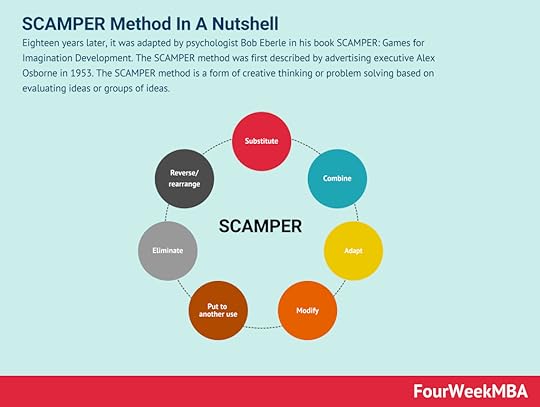 Eighteen years later, it was adapted by psychologist Bob Eberle in his book SCAMPER: Games for Imagination Development. The SCAMPER method was first described by advertising executive Alex Osborne in 1953. The SCAMPER method is a form of creative thinking or problem solving based on evaluating ideas or groups of ideas.
Eighteen years later, it was adapted by psychologist Bob Eberle in his book SCAMPER: Games for Imagination Development. The SCAMPER method was first described by advertising executive Alex Osborne in 1953. The SCAMPER method is a form of creative thinking or problem solving based on evaluating ideas or groups of ideas. The MECE framework is an exhaustive expression of information that must account for all conceivable scenarios. While the framework is used in categorizing information and data processing, it is commonly used in formulating problems and then solving them. The MECE framework is a means of the exhaustive grouping of information into categories that are both mutually exclusive (ME) and collectively exhaustive (CE).
The MECE framework is an exhaustive expression of information that must account for all conceivable scenarios. While the framework is used in categorizing information and data processing, it is commonly used in formulating problems and then solving them. The MECE framework is a means of the exhaustive grouping of information into categories that are both mutually exclusive (ME) and collectively exhaustive (CE). The Nadler-Tushman Congruence Model was created by David Nadler and Michael Tushman at Columbia University. The Nadler-Tushman Congruence Model is a diagnostic tool that identifies problem areas within a company. In the context of business, congruence occurs when the goals of different people or interest groups coincide.
The Nadler-Tushman Congruence Model was created by David Nadler and Michael Tushman at Columbia University. The Nadler-Tushman Congruence Model is a diagnostic tool that identifies problem areas within a company. In the context of business, congruence occurs when the goals of different people or interest groups coincide. Lewin’s change management model helps businesses manage the uncertainty and resistance associated with change. Kurt Lewin, one of the first academics to focus his research on group dynamics, developed a three-stage model. He proposed that the behavior of individuals happened as a function of group behavior.
Lewin’s change management model helps businesses manage the uncertainty and resistance associated with change. Kurt Lewin, one of the first academics to focus his research on group dynamics, developed a three-stage model. He proposed that the behavior of individuals happened as a function of group behavior. Main Free Guides:
Business ModelsBusiness StrategyBusiness DevelopmentDigital Business ModelsDistribution ChannelsMarketing StrategyPlatform Business ModelsTech Business ModelThe post Group Decision-Making Frameworks appeared first on FourWeekMBA.
Coaching Frameworks And Concepts To Help Others Achieve Their Goals
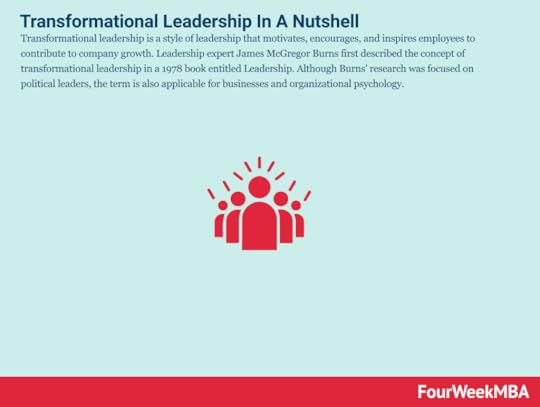 Transformational leadership is a style of leadership that motivates, encourages, and inspires employees to contribute to company growth. Leadership expert James McGregor Burns first described the concept of transformational leadership in a 1978 book entitled Leadership. Although Burns’ research was focused on political leaders, the term is also applicable for businesses and organizational psychology.
Transformational leadership is a style of leadership that motivates, encourages, and inspires employees to contribute to company growth. Leadership expert James McGregor Burns first described the concept of transformational leadership in a 1978 book entitled Leadership. Although Burns’ research was focused on political leaders, the term is also applicable for businesses and organizational psychology. The theory was developed by psychologist Edwin Locke who also has a background in motivation and leadership research. Locke’s goal-setting theory of motivation provides a framework for setting effective and motivating goals. Locke was able to demonstrate that goal setting was linked to performance.
The theory was developed by psychologist Edwin Locke who also has a background in motivation and leadership research. Locke’s goal-setting theory of motivation provides a framework for setting effective and motivating goals. Locke was able to demonstrate that goal setting was linked to performance. Leadership styles encompass the behavioral qualities of a leader. These qualities are commonly used to direct, motivate, or manage groups of people. Some of the most recognized leadership styles include Autocratic, Democratic, or Laissez-Faire leadership styles.
Leadership styles encompass the behavioral qualities of a leader. These qualities are commonly used to direct, motivate, or manage groups of people. Some of the most recognized leadership styles include Autocratic, Democratic, or Laissez-Faire leadership styles.  The Value Disciplines Model was developed by authors Michael Treacy and Fred Wiersema. In their model, the authors use the term value discipline to represent any method a business may use to differentiate itself. The Value Disciplines Model argues that for a business to be viable, it must be successful in three key areas: customer intimacy, product leadership, and operational excellence.
The Value Disciplines Model was developed by authors Michael Treacy and Fred Wiersema. In their model, the authors use the term value discipline to represent any method a business may use to differentiate itself. The Value Disciplines Model argues that for a business to be viable, it must be successful in three key areas: customer intimacy, product leadership, and operational excellence. Tipping Point Leadership is a low-cost means of achieving a strategic shift in an organization by focusing on extremes. Here, the extremes may refer to small groups of people, acts, and activities that exert a disproportionate influence over business performance.
Tipping Point Leadership is a low-cost means of achieving a strategic shift in an organization by focusing on extremes. Here, the extremes may refer to small groups of people, acts, and activities that exert a disproportionate influence over business performance. Amazon fundamental principles that drove and drive the company are:Customer ObsessionOwnershipInvent and SimplifyAre Right, A LotLearn and Be CuriousHire and Develop the BestInsist on the Highest StandardsThink BigBias for ActionFrugalityEarn TrustDive DeepHave Backbone; Disagree and CommitDeliver Results
Amazon fundamental principles that drove and drive the company are:Customer ObsessionOwnershipInvent and SimplifyAre Right, A LotLearn and Be CuriousHire and Develop the BestInsist on the Highest StandardsThink BigBias for ActionFrugalityEarn TrustDive DeepHave Backbone; Disagree and CommitDeliver Results A personal mission statement clarifies what is important in life to an individual. A personal mission statement is a written statement of purpose that allows individuals to define their calling in life. It helps clarify goals, values, beliefs, or passions, communicate them, and better execute a personal growth strategy.
A personal mission statement clarifies what is important in life to an individual. A personal mission statement is a written statement of purpose that allows individuals to define their calling in life. It helps clarify goals, values, beliefs, or passions, communicate them, and better execute a personal growth strategy. 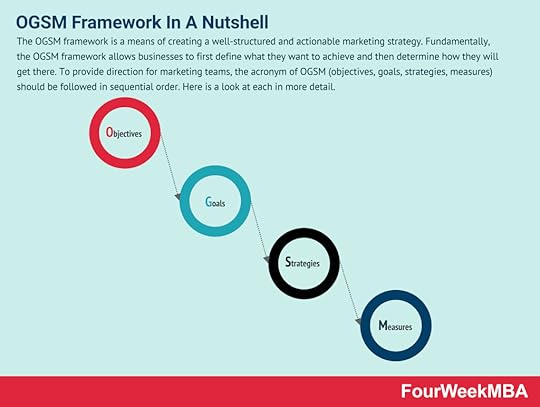 The OGSM framework is a means of creating a well-structured and actionable marketing strategy. Fundamentally, the OGSM framework allows businesses to first define what they want to achieve and then determine how they will get there. To provide direction for marketing teams, the acronym of OGSM (objectives, goals, strategies, measures) should be followed in sequential order. Here is a look at each in more detail.
The OGSM framework is a means of creating a well-structured and actionable marketing strategy. Fundamentally, the OGSM framework allows businesses to first define what they want to achieve and then determine how they will get there. To provide direction for marketing teams, the acronym of OGSM (objectives, goals, strategies, measures) should be followed in sequential order. Here is a look at each in more detail. A SMART goal is any goal with a carefully planned, concise, and trackable objective. To be such a goal needs to be specific, measurable, achievable, relevant, and time-based. Bringing structure and trackability to goal setting increases the chances goals will be achieved, and it helps align the organization around those goals.
A SMART goal is any goal with a carefully planned, concise, and trackable objective. To be such a goal needs to be specific, measurable, achievable, relevant, and time-based. Bringing structure and trackability to goal setting increases the chances goals will be achieved, and it helps align the organization around those goals. Moonshot thinking is an approach to innovation, and it can be applied to business or any other discipline where you target at least 10X goals. That shifts the mindset, and it empowers a team of people to look for unconventional solutions, thus starting from first principles, by leveraging on fast-paced experimentation.
Moonshot thinking is an approach to innovation, and it can be applied to business or any other discipline where you target at least 10X goals. That shifts the mindset, and it empowers a team of people to look for unconventional solutions, thus starting from first principles, by leveraging on fast-paced experimentation.Main Free Guides:
Business ModelsBusiness StrategyBusiness DevelopmentDigital Business ModelsDistribution ChannelsMarketing StrategyPlatform Business ModelsTech Business ModelThe post Coaching Frameworks And Concepts To Help Others Achieve Their Goals appeared first on FourWeekMBA.
January 24, 2021
Kano Model Explained For Business
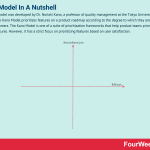
The Kano Model was developed by Dr. Noriaki Kano, a professor of quality management at the Tokyo University of Science. The Kano Model prioritizes features on a product roadmap according to the degree to which they are likely to satisfy customers. The Kano Model is one of a suite of prioritization frameworks that help product teams prioritize product features. However, it has a strict focus on prioritizing features based on user satisfaction.
Understanding the Kano ModelThrough extensive research, Dr. Kano determined the factors most responsible for customer loyalty and satisfaction with the creation of five categories. Each category describes the potential reaction of a customer to a product or service feature – ranging from dissatisfaction to delight.
As a result, teams using the Kano Model must consider new product features according to the potential of each to satisfy customers based on functionality.
The Kano Model feature categoriesAs noted earlier, the Kano Model identifies five category features based on the reaction of a customer. It’s important to note that customer reactions are based on whether a given product feature is absent (dysfunctional) or present (functional).
With that in mind, let’s take a look at each in more detail:
Dissatisfaction features – customers are likely to be upset by the presence of these features, but not dissatisfied if they are absent.Indifferent features – the presence or absence of these features does not make a perceptible difference in the reaction of the customer. If present, they are simply tolerated.Basic (threshold) features – or features a product needs to be competitive that customers expect. Turn signals on a new car are one such example. These features are not generally desired by customers but they may dislike not having them. In many situations, these product features are compulsory in that they are essential to the operation of the product.Excitement features – Kano called these features “delighters” because of their ability to delight and excite customers who weren’t expecting to have them. They often provide an increase in customer delight that is disproportional to the investment required to implement them. Delighters can drive brand loyalty and increase word-of-mouth advertising.Performance features – encompassing features that where investment is proportionally related to customer satisfaction. Performance features are those that the customer likes having and dislikes not having. As a result of the linear relationship between investment and satisfaction, Kano noted that these features were one-dimensional. Nevertheless, customers use these features to weigh up buying decisions. A phone company that invests in a better network to offer consumers faster browsing speeds is one example of a performance feature.Key takeaways:The Kano Model is a product feature prioritising framework based on potential customer reaction and satisfaction.The Kano Model is unique among prioritization frameworks because it is solely focused on assessing product features based on their presence (functionality) or absence (dysfunctionality).The Kano Model splits customer reactions to a product feature into five categories: dissatisfaction, indifferent, basic, excitement, and performance. Businesses must avoid the first two categories and focus on categories likely to drive customer loyalty and retention.Read Next: Business Analysis, Competitor Analysis, Continuous Innovation, Agile Methodology, Lean Startup, Business Model Innovation, Project Management.
Main Free Guides:
Business ModelsBusiness StrategyBusiness DevelopmentDigital Business ModelsDistribution ChannelsMarketing StrategyPlatform Business ModelsTech Business ModelThe post Kano Model Explained For Business appeared first on FourWeekMBA.



